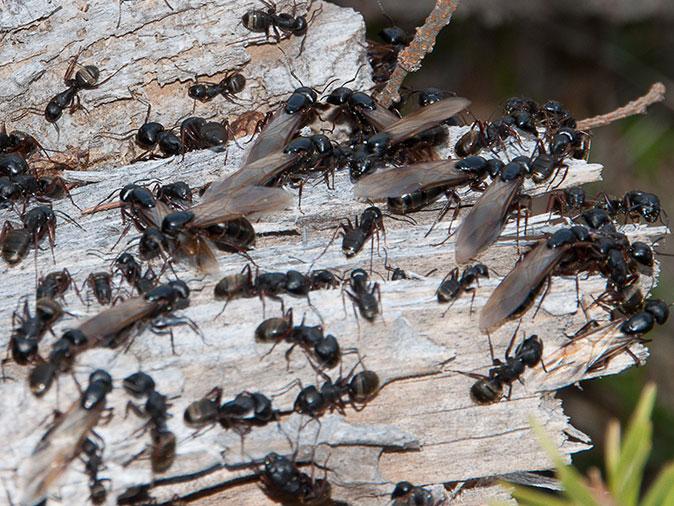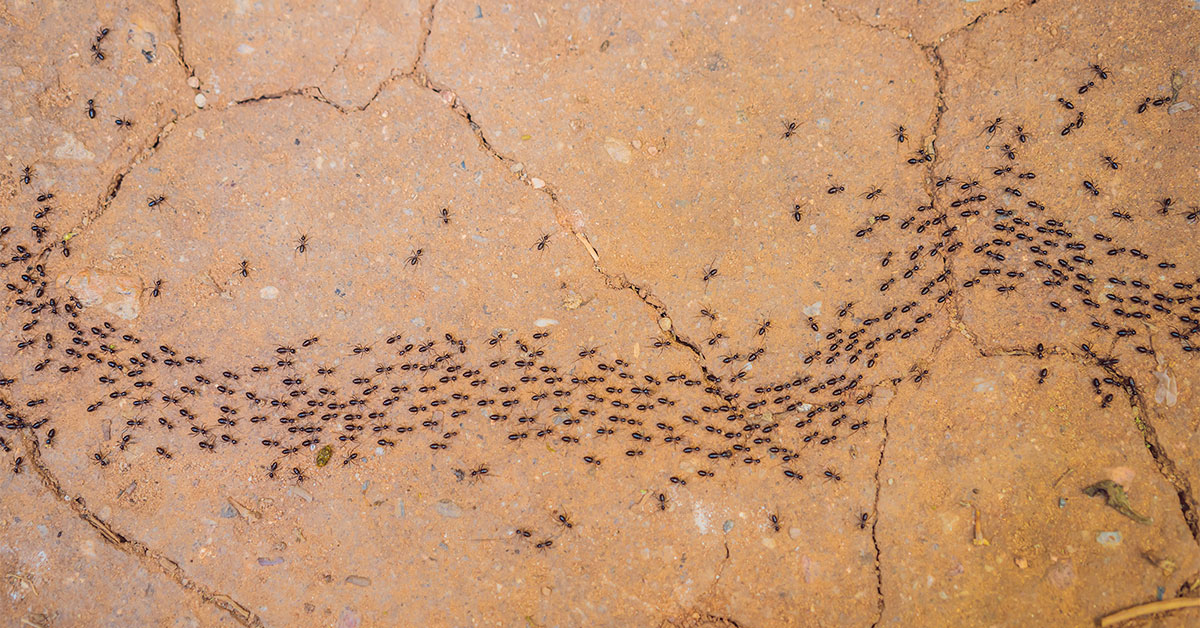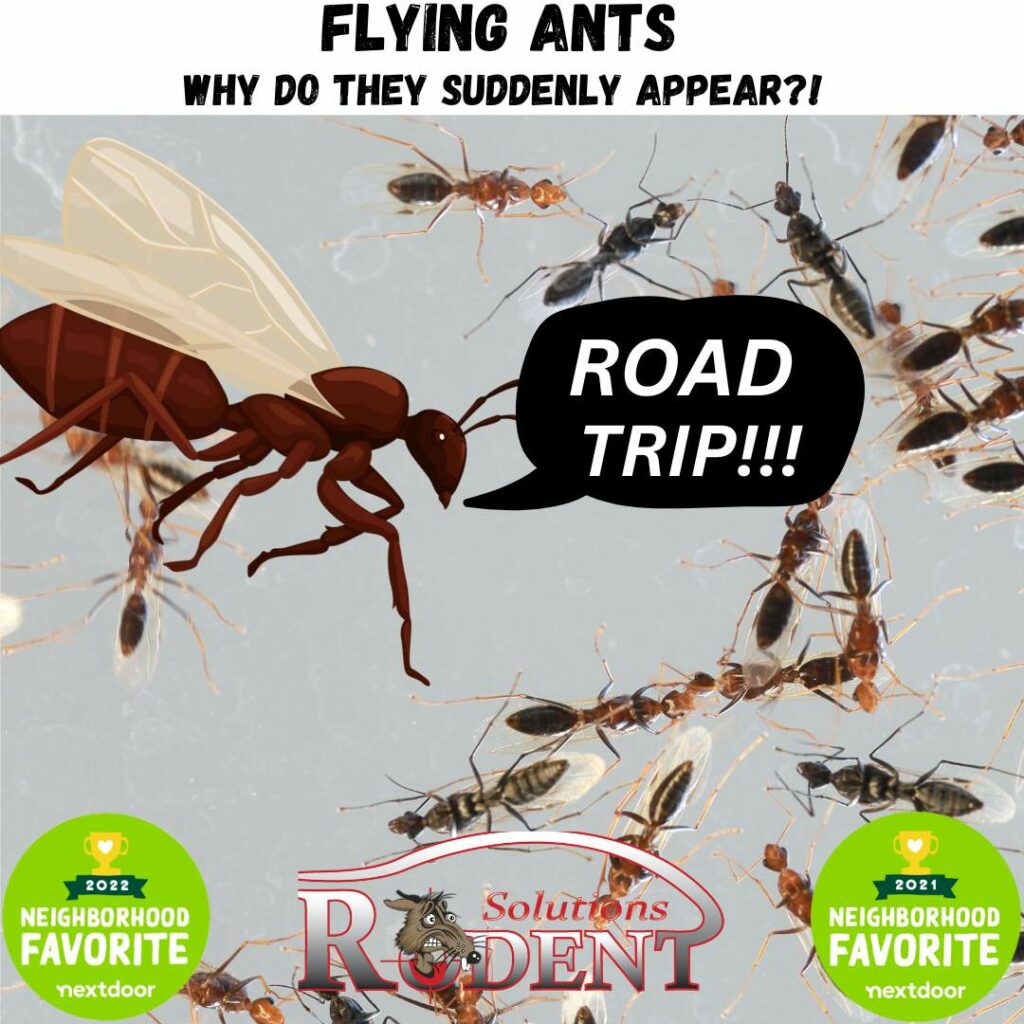Ants suddenly appear in response to food sources or changes in weather. Environmental cues like rain or heat can drive them indoors.
Ants have a notorious reputation for infiltrating homes and outdoor spaces, often prompted by the simplest of motivators: survival. These persistent insects are in constant search for nutrients to sustain their colonies, which can lead them to discover even the smallest crumbs left behind on floors or counters.
Severe weather conditions, such as heavy rains flooding their nests or extreme heat, can also push ants to seek refuge and more favorable conditions inside human dwellings. Swiftly emerging in large numbers, ants utilize their impressive foraging abilities to gather food, shelter, or establish new colonies, leading to those unexpected parades across your kitchen counter or patio. Understanding these triggers is crucial for effective ant control and maintaining a pest-free environment.

Credit: www.arrownj.com
Ant Invasions Decoded
Ants are remarkable creatures, known for their hard work and complex societies. Sometimes, you might notice them appearing in large numbers with no warning. Understanding why ants suddenly appear can help prevent and manage these invasions in your space.
A Seasonal Surge
Ant populations can explode during certain times of the year. This seasonal surge corresponds with their life cycles and the quest for resources. Let’s break down why:
- Warmth: Spring and summer warmth encourages ant activity.
- Moisture: Rainfall can flood ant colonies, prompting relocation.
- Food: Ants seek food to support their growing colonies.
This increase in activity is a natural part of their survival strategy.
Scout Ants: The Pioneers
Before an invasion, scout ants lead the charge. These pioneering ants are the ones you see first:
| Scout Ant Role | Description |
|---|---|
| Explorers: | They look for food and resources. |
| Messengers: | When they find food, they tell others. |
| Trailblazers: | They leave scent trails for others to follow. |
Once a scout finds a food source, it lays down a pheromone trail. This trail leads other ants to the bounty, and soon, you have a full-blown ant invasion.

Credit: www.newleafpestcontrol.com
Ants In The Home
Picture this: You wake up to a trail of ants marching across your kitchen counter. These tiny invaders often take homeowners by surprise as they seek out the essentials for survival within our cozy abodes. But what exactly brings ants into our space?
Searching For Sustenance
Kitchens and pantries are ant magnets. Crumbs, spills, and sugary spills are open invitations. Ants have powerful olfactory receptors, meaning they can sniff out food from afar. Here’s how they operate:
- Scout ants leave the nest in search of food.
- When they find food, they return to the nest leaving a scent trail.
- This trail guides other ants to the food source swiftly.
Seeking Shelter And Warmth
Homes provide perfect nesting spots for ants seeking refuge from the outside world. Factors attracting ants include:
| Shelter Need | Reason Ants Enter Homes |
|---|---|
| Warmth | Houses maintain steady temperatures ants need. |
| Moisture | Leaky pipes and damp areas give ants necessary water. |
| Protection | Ants escape predators by hiding in small crevices indoors. |
Unseen Attractants
The sudden appearance of ants in your home often leaves many scratching their heads in wonder. But, behind this mysterious influx lies a world of unseen attractants that beckon these tiny critters right into your space. Let’s peel back the curtain to discover just what lures ants indoors.
Traces Humans Leave
It’s no secret, ants have a knack for finding the smallest crumbs. These intelligent foragers can detect the trails we inadvertently leave behind.
- Food crumbs: Even a single crumb from a sandwich can lead an ant parade into your home.
- Spilled drinks: Sticky soda spills are sweet siren calls for ants.
- Grease stains: The faintest grease spot provides a feast for these scouts.
Clean up regularly, paying extra attention to kitchen surfaces and dining areas, to disrupt these invisible trails.
Moisture Matters
Ants seek out moist environments. Your home’s damp areas can serve as an oasis for these tiny creatures, especially in dry periods.
| Moisture Sources | Ant Magnets |
|---|---|
| Leaky pipes | Water is life for ants; fix leaks promptly. |
| Wet countertops | Drying surfaces prevent pooling that attracts ants. |
| Humid basements | Dehumidifiers help keep these areas less inviting. |
Ensuring areas stay dry is key in deterring ant intruders. Regular inspections for excess moisture can keep your home less appealing to these persistent pests.

Credit: www.myheronhome.com
Life Cycle And Breeding
Ants are fascinating creatures. Their life cycle begins as an egg. Then it changes into a larva, pupa, and finally, an adult. Their breeding patterns can dramatically increase their numbers. Late spring and early summer are prime times for expansion within ant colonies. Understanding these cycles helps explain why ants appear seemingly out of nowhere.
Colony Expansion
Colony expansion is essential for survival. Worker ants work tirelessly to feed and protect their growing family. A single queen ant can lay hundreds of eggs. This influx of new members causes the colony to swell.
- Mature colonies decide it’s time to create new nests.
- Worker ants spread out to gather resources and space.
- Ants may invade homes in search of food and shelter.
Nuptial Flight: The Ant Exodus
Nuptial flight, often called the ant exodus, is an incredible event. Virgin queen ants and male ants take flight for breeding. It occurs during warm, humid days, often after rain.
- Future queens and males fly out of the colony.
- They mate in the air during flight.
- The queens land, shed their wings, and start new colonies.
The sight of ant swarms can be alarming, but it’s a natural part of ant life. It signals their breeding process is in full swing. If you notice more ants during this time, it’s likely due to nuptial flights in your area.
Environmental Factors
Have you ever wondered why ants suddenly invade your space? Environmental factors play a crucial role in this phenomenon. Changes in weather and disturbances in their natural habitat often trigger ants to search for new homes and food sources. Let’s dive into how these factors contribute to their unexpected arrival.
Weather Patterns
Ants are sensitive to weather changes. They respond to the environment around them. Rain, for instance, can flood their homes, forcing them to relocate. Dry spells can drive them inside your home in search of water. Here is a quick overview of how different weather scenarios impact ant behavior:
| Weather Condition | Ant Behavior |
|---|---|
| Heavy Rain | Ants seek shelter and food indoors. |
| Extreme Heat | Ants require more water, may enter homes. |
| Cold Temperatures | Ants hibernate or find warm areas. |
Natural Habitat Disruption
Ants live in well-organized colonies, usually underground. Any disruption to this setup compels them to relocate. Construction, landscaping, and even children’s play can disturb ant habitats. The ripple effect can result in ants appearing where they were not seen before. A bulleted list highlights common disruptions:
- Land development projects
- Gardening or lawn care
- Natural events like erosion or fallen trees
Understanding these environmental triggers helps explain why ants might be marching into your area. Ants adapt quickly and look for the most favorable conditions to survive and thrive. Knowing what draws them can aid in managing their presence effectively.
Ant Communication
Ants are social insects with complex behaviors. They work together like a well-oiled machine. One key to their success is how they communicate. Ants send messages to each other in fascinating ways. Understanding their communication helps explain why they sometimes appear in large numbers.
Chemical Trails
Ants use chemicals called pheromones to talk to each other. When an ant finds food, it leaves a pheromone trail. This trail is like a map for other ants. They follow the scent to the food source. The trail gets stronger as more ants walk over it. It’s a signpost that guides the entire colony.
The Collective Swarm
The behavior of a group of ants is called the collective swarm. Ants work as a unit. They make decisions as a group. When the colony needs to move, every ant follows the chemical trails. This swarm intelligence is why we see big groups of ants seemingly out of nowhere.
We can learn a lot about cooperation from ants. Their communication is all about teamwork. Next time a line of ants appears, remember, it’s their way of talking!
Preventative Measures
An unseen army of ants can invade a home without warning. Frequent encounters with these tiny intruders point to the need for preventative measures. Implementing a few key strategies can keep these uninvited guests at bay. Explore how sanitation and physical barriers help maintain an ant-free environment.
Sanitation Strategies
Ants march towards food and sticky residues. Keeping spaces clean is the first line of defense. Let’s explore effective sanitation strategies:
- Wipe surfaces after meal prep to remove crumbs and spills.
- Store food in sealed containers.
- Dispose of trash regularly and use bins with tight-fitting lids.
- Avoid leaving pet food out for long periods.
- Clean spills immediately, especially sugary liquids.
Physical Barriers
Block entry points to stop ants from coming inside. Here’s how to create effective barriers:
| Barrier | Application |
|---|---|
| Caulk | Seal cracks and crevices around windows, doors, and foundations. |
| Weather-stripping | Apply to doors and windows to close gaps. |
| Door sweeps | Install on the bottom of doors, especially those leading outside. |
Use ants’ aversion to certain substances to your advantage. Sprinkle diatomaceous earth, baby powder, or cinnamon near entry points. These act as natural deterrents.
Professional And Natural Ant Control
Sudden ant invasions puzzle many homeowners. Understanding why ants enter can guide us to prevent these tiny pests effectively. Ant control comes in two main types: professional extermination and natural repellents. Both aim to keep our spaces ant-free while considering safety and environmental impacts.
Extermination Options
Professional extermination offers a direct approach to ant control. Certified exterminators use various methods to target ant colonies.
- Bait stations attract and poison ants, ensuring they carry lethal substances back to their colony.
- Sprays act fast, killing ants on contact and deterring new ones from entering.
- Powders and gels provide a residual effect, preventing future infestations.
These solutions often require follow-up treatments to ensure total eradication.
Eco-friendly Repellents
For those seeking eco-conscious alternatives, natural repellents are a go-to option. They pose minimal risks to pets and humans.
| Repellent | Use |
|---|---|
| Vinegar | Wipe surfaces to erase ant trails. |
| Essential oils | Deter ants with peppermint or lemon scents. |
| Diatomaceous earth | Spread around entry points to damage ant exoskeletons. |
Combining these repellents with regular cleaning and sealing entry points can enhance their effectiveness.
Frequently Asked Questions On Why Do Ants Suddenly Appear?
Why Do Ants Come Inside Homes?
Ants often enter homes seeking food, especially sugary or greasy items. They are attracted to spills, exposed food, and pet food bowls.
What Causes An Increase In Ant Activity?
Ants may increase in activity due to environmental changes like heavy rain, drought, or extreme heat, which drive them to seek refuge and resources indoors.
How Can You Prevent Ants From Appearing?
Keeping your home clean, sealing entry points, and storing food in airtight containers can help prevent ants. Regular cleaning helps remove the scent trails ants follow.
Do Ants Appear More In A Specific Season?
Yes, ants are more active during warmer months, typically spring and summer, as they search for food to stock up for colder periods.
Conclusion
Ant colonies thrive on persistence and resourcefulness. This post has illuminated the reasons behind their sudden appearances. From seeking food to escaping threats, ants are driven by survival. Remember, managing cleanliness can often prevent these surprise visits. Maintain vigilance and coexist with nature’s tiny foragers.

I’m MD Tanvir, and I bring years of expertise gained from working closely with pest control companies to the forefront. My journey in the industry has inspired me to launch Bug Battler, a platform aimed at equipping people with the know-how to combat pests autonomously. Through Bug Battler, I aim to empower individuals with practical insights to tackle pest infestations effectively.

